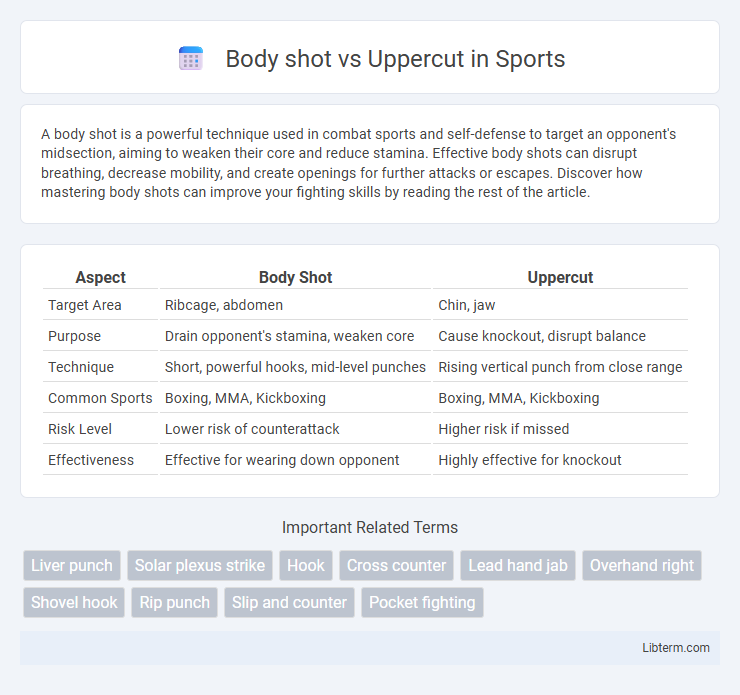A body shot is a powerful technique used in combat sports and self-defense to target an opponent's midsection, aiming to weaken their core and reduce stamina. Effective body shots can disrupt breathing, decrease mobility, and create openings for further attacks or escapes. Discover how mastering body shots can improve your fighting skills by reading the rest of the article.
Table of Comparison
| Aspect | Body Shot | Uppercut |
|---|---|---|
| Target Area | Ribcage, abdomen | Chin, jaw |
| Purpose | Drain opponent's stamina, weaken core | Cause knockout, disrupt balance |
| Technique | Short, powerful hooks, mid-level punches | Rising vertical punch from close range |
| Common Sports | Boxing, MMA, Kickboxing | Boxing, MMA, Kickboxing |
| Risk Level | Lower risk of counterattack | Higher risk if missed |
| Effectiveness | Effective for wearing down opponent | Highly effective for knockout |
Body Shot vs Uppercut: Key Differences
Body shots target the torso, aiming to weaken the opponent's core and reduce stamina through powerful punches to the ribs or abdomen. Uppercuts are vertical punches directed at the chin or jaw, designed to cause a knockout by exploiting the opponent's upward defense gaps. The key differences lie in the target areas and tactical purposes: body shots focus on endurance depletion, while uppercuts focus on quick, decisive damage.
Anatomy of a Body Shot
A body shot targets the ribs, liver, and solar plexus, exploiting vulnerable areas packed with nerves and vital organs to disrupt an opponent's breathing and balance. Delivered with a hook or straight punch, it aims to weaken the core muscles, causing intense pain and reducing mobility. Uppercuts, in contrast, focus on the chin and jawline, leveraging upward force to potentially cause knockouts by impacting the central nervous system and facial anatomy.
Anatomy of an Uppercut
An uppercut targets the opponent's chin or jaw, leveraging explosive power from the legs and hips to generate upward force, making use of fast-twitch muscle fibers in the quadriceps and glutes. Unlike a body shot aimed at the ribs or solar plexus to disrupt breathing, the uppercut relies on coordinated core engagement, including the obliques and transverse abdominis, to stabilize and rotate the torso effectively. Precise biomechanics of the uppercut maximize kinetic energy transfer, focusing on short-range impact that exploits vulnerable jaw and neck anatomy to induce knockouts.
Power Generation: Body Shot vs Uppercut
Power generation in a body shot primarily comes from the rotation of the hips and the engagement of the core muscles to drive force into the opponent's midsection. In contrast, the uppercut relies heavily on leg drive and explosive upward motion, utilizing the knees and hips to generate upward momentum and deliver significant power beneath the opponent's guard. Both punches maximize kinetic energy transfer through proper weight shifting and torque, but the uppercut's power is often more vertical, while the body shot emphasizes rotational torque for impactful force.
Target Areas and Impact
Body shots target the ribs, solar plexus, and liver, aiming to weaken the opponent by causing pain and disrupting breathing, often lowering their guard. Uppercuts focus on the chin and jawbone, delivering powerful upward force designed to cause knockouts through rapid head movement and concussion. Both punches exploit vulnerable anatomical points but differ in angle and tactical purpose, with body shots breaking stamina and uppercuts seeking immediate stoppage.
Timing and Distance
Effective body shots require closing the distance with precise timing to exploit an opponent's guard lower than their head, often landing during openings created by their jab or stance shifts. Uppercuts depend on close-range proximity and perfect timing to catch an opponent off-guard under the chin, typically executed during an opponent's forward motion or as a counter to a missed punch. Proper control of range and anticipation of an opponent's movement ensures maximum impact and minimizes exposure to counters for both body shots and uppercuts.
Defensive Counters
Body shots target the midsection, forcing opponents to lower their guard and creating openings for defensive counters like slipping and countering with hooks. Uppercuts aim at the chin or jaw, often exploited defensively by leaning back or using parries to deflect and respond with powerful straight punches. Effective counter strategies involve precise timing and positioning to capitalize on the opponent's momentary vulnerability after committing to either a body shot or an uppercut.
Best Situations to Use Each Punch
A body shot is most effective when an opponent drops their guard or leans forward, allowing a powerful strike to the ribs that can weaken stamina and slow movement. Uppercuts excel in close-range combat, targeting the opponent's chin during defensive slips or when they lower their head, aiming for knockouts or creating openings. Utilizing a body shot during mid-fight fatigue phases and an uppercut during tight exchanges maximizes offensive impact in boxing strategy.
Common Mistakes Boxers Make
Common mistakes boxers make with body shots include telegraphing punches by dropping their guard too early, leaving them vulnerable to counterattacks, and failing to maintain proper distance, which reduces power and accuracy. When throwing uppercuts, many fighters err by raising their elbows too high, compromising balance and exposing themselves to hooks. Neglecting hip rotation and proper foot positioning is a frequent error in both punches, diminishing effectiveness and increasing injury risk.
Which is More Effective: Body Shot or Uppercut?
The uppercut is generally more effective for knockout power due to its upward trajectory targeting the chin and jaw, areas critical for disrupting brain function. Body shots, while less likely to cause immediate knockouts, can drain an opponent's stamina by targeting the liver and ribs, leading to long-term damage and decreased performance. Fighters often combine uppercuts with body shots to maximize damage and control during a match.
Body shot Infographic

 libterm.com
libterm.com